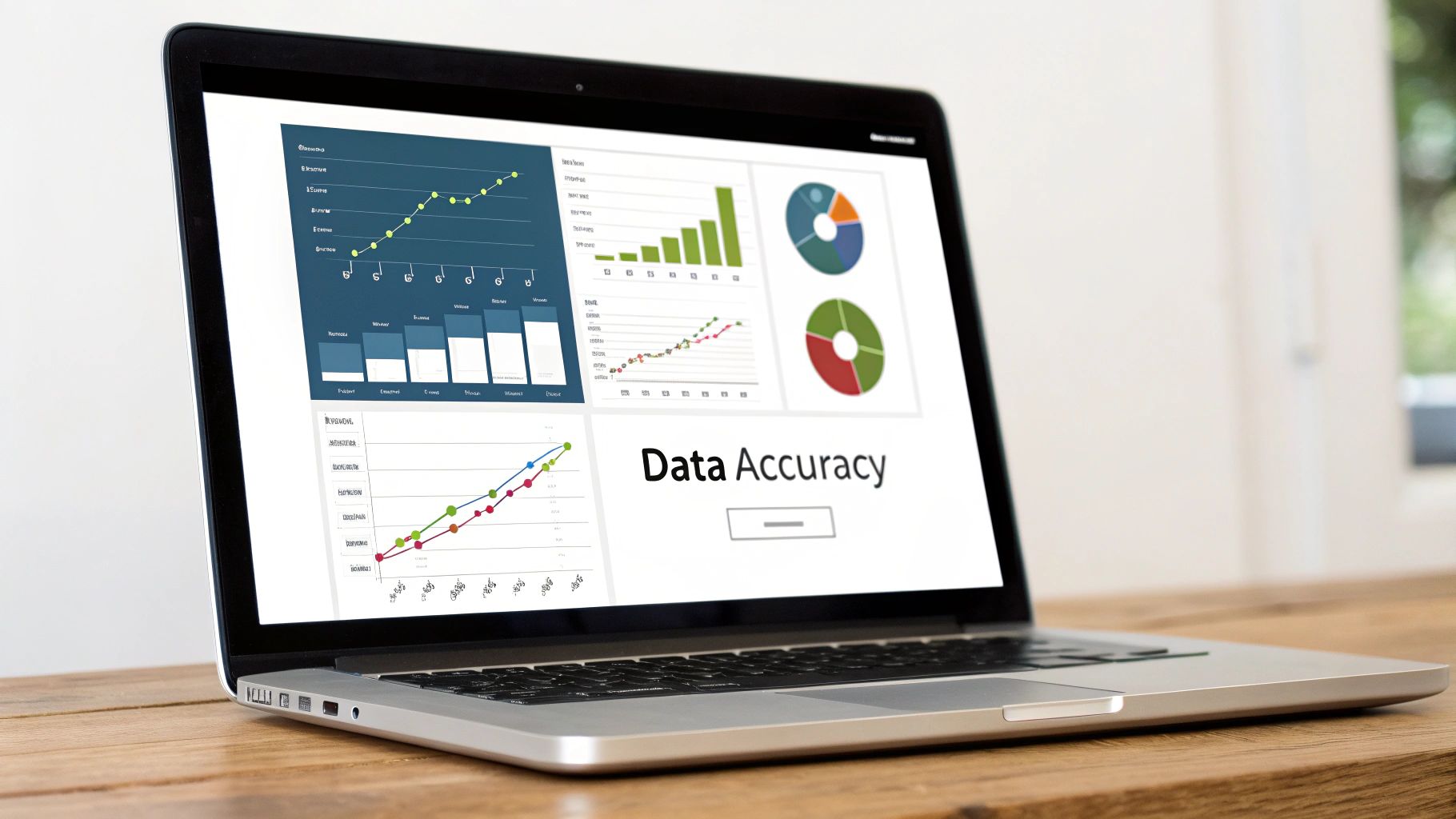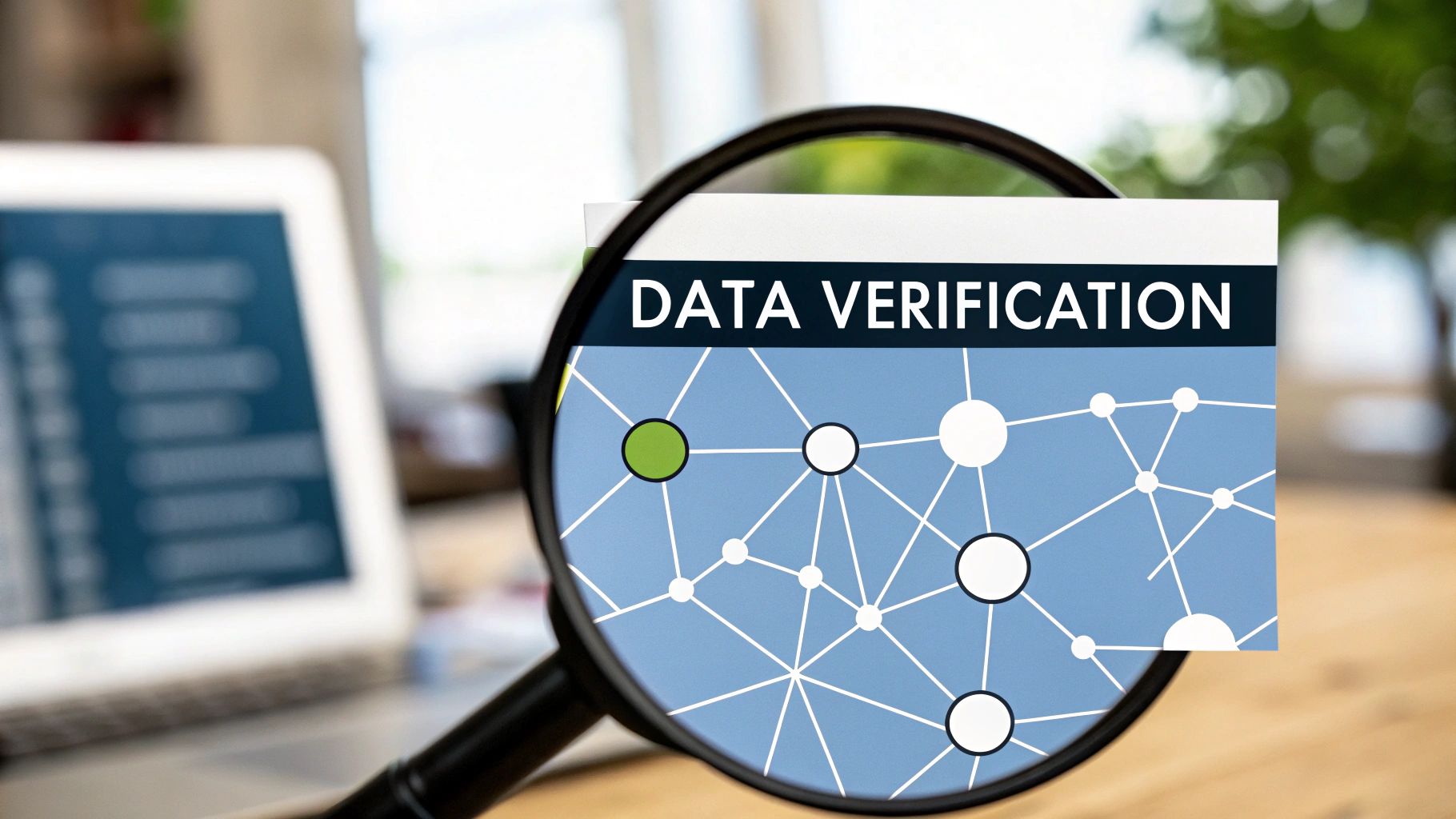The Complete Guide to Data Validation Best Practices: From Chaos to Confidence
Understanding the New World of Data Validation

Data validation has become essential for making smart business decisions based on reliable information. For data teams, thorough validation isn't optional anymore - it's a core requirement. The focus has shifted from basic manual reviews to building strong systems that catch problems early.
Why Traditional Data Validation Falls Short
Old validation methods that rely on manual checks and simple rules take too much time and often miss errors. These approaches can't keep up with how quickly data moves through modern companies. They also struggle to adapt when business needs change or data gets more complex. Manual validation creates slowdowns that hurt efficiency and block improvements.
The Pillars of Modern Data Validation
Good data validation today focuses on building systems that can grow with your needs. This means creating clear validation rules for data formats, value ranges, and unusual cases. Having specific rules ensures data follows business requirements and stays consistent. For example, email fields should only accept valid email addresses, and number fields must stay within defined ranges. These guidelines help prevent data problems and maintain quality. Learn more: Data Validation: Essential Practices for Accuracy
Modern validation also emphasizes automation. Using automated checks reduces manual work, speeds up validation, and prevents human mistakes. But automation goes beyond just replacing manual tasks - it also adds advanced features like real-time checks and smart anomaly detection powered by machine learning.
Building a Data Validation Framework That Scales
A good validation framework needs both technical capabilities and clear processes. On the technical side, it should include different types of checks - from basic format validation to complex business rules. For instance, confirming date fields contain real dates or verifying customer IDs exist in your database. The framework also needs defined steps for handling errors, tracking data quality, and updating validation rules over time.
You'll also need to assign clear ownership of data quality within your company. Figure out if data engineers, analysts, or a dedicated team will be responsible. Having defined roles helps build a culture where quality matters. When validation becomes a natural part of working with data, not an afterthought, you create a strong foundation for reliable insights.
Mastering the Art of Automated Validation

Effective data validation requires smart automation that goes beyond basic scripting. Building reliable validation systems means carefully selecting tools, creating strong rules, and knowing when human oversight is needed.
Choosing the Right Automation Tools
You have many options when it comes to data validation tools. Some plug directly into data pipelines for instant validation, while others offer extensive checks including statistics and anomaly detection. When picking tools, focus on: how well they scale, how easily they work with your current systems, and what validation rules you need. Pull Checklist helps make validation part of your code review process, keeping data quality front-of-mind and catching issues early.
Defining Robust Validation Rules
Your automated validation is only as good as its rules. Create clear rules for checking data types, formats, ranges and consistency. For example, validate email formats, confirm numbers fall within expected ranges, and verify internal data matches up. Add rules specific to your business needs too - like checking customer IDs against your database or flagging unusual order totals.
Automated tools help spot errors consistently without human bias. Tools like Great Expectations can find problems automatically and alert teams right away. Real-time validation means catching issues instantly before they spread through your systems. Want to learn more about validation best practices? Check out this guide on Data Validation Methods and Best Practices.
The Human Element: Strategic Oversight
While automation does the heavy lifting, human judgment remains key. Automated systems excel at finding expected issues but may miss subtle problems. Make time to review validation reports, check into flagged anomalies, and update rules as your business needs change. This combination of automated checks and human insight creates stronger validation.
Avoiding Common Automation Pitfalls
Be careful not to rely too heavily on automation alone. Don't assume automated systems will catch everything - include manual spot checks and reviews to verify things work properly. Also, keep your validation rules current. As your business grows and changes, so should your rules. This helps prevent alert fatigue where teams start ignoring notifications because many are outdated or irrelevant. Stay aware of these common issues to get the most from your automated validation.
Creating Validation Rules That Actually Work

Good data validation comes down to smart, practical rules - not just automated checks. The most successful companies focus on validation rules that work in real situations and can handle messy, complex data.
Balancing Strictness with Business Reality
Your validation rules need to protect data quality without getting in the way of normal business. For example, strictly requiring US-format phone numbers would reject valid international numbers. Better rules allow different formats while ensuring the key elements are there.
Handling Edge Cases and Exceptions
Real data rarely fits perfectly into predefined boxes. When building validation rules, plan for those unusual cases that are technically valid but don't match standard patterns. One effective approach is to flag potential exceptions for manual review rather than automatically rejecting them. This keeps data flowing while maintaining quality standards.
Building Evolvable Rule Sets
As your business grows and changes, your validation rules should adapt too. Set up your rules in a central place where they're easy to update. Use version control to track changes over time. This lets you quickly adjust to new data types and changing needs without starting from scratch.
Documentation and Maintainability
Clear documentation is essential - each rule should explain what it checks, why it matters, and how it works. Good docs help new team members get up to speed and keep everyone consistent. Tools like Pull Checklist can help by adding validation checks right into code reviews.
Consider using a table like this to organize your rules:
| Field | Rule | Description | Error Message | |---|---|---|---| | Email | Valid Email Format | Ensures the email address is correctly formatted. | Invalid email address. | | Phone Number | International Format Allowed | Accepts various phone number formats. | Please enter a valid phone number. | | Order Total | Positive Value | Order totals must be greater than zero. | Order total must be a positive value. | | Customer ID | Exists in Database | Checks if the provided customer ID exists. | Invalid customer ID. |
This structured approach makes it easy to spot gaps in your validation and keeps everyone on the same page. Focus on clear documentation and adaptable rules to build validation that actually works in practice.
Building Real-Time Validation That Scales

Building fast, reliable data validation doesn't have to slow down your system. Here's how to catch errors instantly while keeping your operations smooth and ready for growth.
Practical Approaches to Distributed Validation
When handling large data volumes, distributed validation helps spread the workload across multiple machines. Message queues are a great way to do this - they let you add incoming data to a queue and process it with multiple validation workers at once. This stops any single validator from getting overwhelmed.
Think about validating sensor data from IoT devices. One validator would struggle, but a distributed system handles the data streams smoothly. You can check information in real time and spot problems quickly.
Strategies for High-Volume Data Streams
Speed matters when processing fast-moving data. In-memory data grids and caching help by storing validation rules where they're quickly accessible. This beats having to pull them from disk each time.
Tools like Apache Kafka excel at processing high-volume data streams. They help you build validation pipelines that work smoothly with your existing systems.
Maintaining Accuracy Under Pressure
As data grows larger and faster, keeping validation accurate gets harder. Regular testing and updating of validation rules helps catch new types of errors as they emerge.
Automated monitoring systems track key metrics like error rates and processing speed. They can alert you when unusual patterns appear. Tools like Pull Checklist integrate validation checks right into your development process for constant quality control.
Building for Scalability and Reliability
Creating a scalable validation system needs careful planning. Here are key best practices:
- Modular Design: Split validation logic into small, reusable pieces. This makes updates and scaling easier.
- Stateless Validation: Make each validation check independent. This improves reliability and makes scaling simpler.
- Configuration Management: Keep validation rules in one central place. This makes updates easier across your whole system.
Following these approaches helps build validation systems that handle growing data volumes while staying fast and accurate. Your data stays reliable, even under heavy loads.
Converting Error Data into Business Insights
Error messages and data validation problems often make teams groan, but these "failures" actually provide valuable clues for improving your systems and processes. By examining error patterns carefully, you can spot opportunities to boost data quality and make smarter business decisions.
Learning from Your Data Validation Issues
Think of each error as a signal pointing to potential process gaps. For example, if customer phone numbers consistently fail validation, this might reveal confusing input forms or unclear user instructions. Regular analysis of these patterns helps catch systemic problems that could otherwise go undetected.
Your validation rules themselves may need tuning based on real-world usage. Some rules might be too strict and flag valid data, while others might be too loose and let problems slip through. The key is regularly reviewing which errors occur and updating your validation approach accordingly. Focus on finding and fixing root causes rather than just putting out fires.
Creating a System for Error Analysis
To get real value from validation errors, you need an organized approach to tracking and handling them. Start by grouping errors into clear categories like format issues, logic problems, or missing data. This helps identify trends and set fix priorities.
Set up clear steps for who handles each type of error and how they should resolve it. Tools like Pull Checklist can help automate error handling workflows by building validation directly into your development process. This catches problems earlier and prevents them from cascading into bigger issues downstream.
Making Data Quality Improvements
Getting strategic about error handling is an ongoing effort. By studying validation issues closely, you gain insights into data quality gaps and process weaknesses. Use this information to strengthen your data collection methods and validation rules over time. Move from simply fixing errors to proactively preventing them.
Track these key metrics to measure your progress:
| Metric | Description | |---|---| | Error Rate | Percentage of records with errors. A decreasing trend indicates improvement. | | Error Resolution Time | Time taken to resolve an error. Faster resolution reduces the impact of errors. | | Error Type Distribution | Breakdown of errors by category. Helps identify recurring problems and prioritize fixes. | | Impact of Errors on Business Decisions | Assessment of how errors affect key metrics and decision-making. Demonstrates the value of improved data quality. |
Monitor these numbers regularly to ensure your data validation efforts deliver real results. Over time, you'll build a system where each error leads to meaningful improvements in your data quality and business insights.
Measuring What Matters in Data Validation
Counting errors is just the beginning of effective data validation. Smart businesses track specific metrics that reveal how well their validation processes actually work. This means creating actionable dashboards, setting up proactive monitoring, and generating reports that drive real improvements.
Key Performance Indicators for Data Validation
Understanding validation effectiveness requires tracking the right metrics. Here are key indicators that provide real insight:
- Validation Rule Effectiveness: Monitor how often each rule fires and catches actual issues. This helps identify rules that are too strict or too loose. For example, if an email validation rule flags 90% of entries as invalid, it's probably overly restrictive.
- Error Rate: Track the percentage of records with errors over time. A downward trend shows improving data quality. Compare rates across data sources to find problem areas.
- Error Resolution Time: Calculate how quickly issues get fixed. Slow resolution can point to bottlenecks in your workflows that need attention.
- Data Completeness: Check what percentage of required fields contain valid data. Missing crucial information like customer details makes analysis much harder.
Building Meaningful Dashboards and Reports
Good dashboards make validation metrics easy to understand at a glance. They should display trends clearly, highlight issues quickly, and show progress toward quality goals. This helps teams spot problems early and make smart choices about process improvements.
Regular reports help communicate results to stakeholders and show the impact of validation efforts. Reports should cover key metrics, point out patterns, and suggest specific fixes. For example, if the same error keeps appearing, you may need to revise that validation rule or data collection step.
Setting Realistic Benchmarks and Tracking Progress
Set clear, measurable goals for your validation metrics. Make them specific and achievable within a set timeframe. For instance, target reducing error rates by 10% in the next three months.
Check progress regularly and adjust your approach when needed. If you're missing targets, examine why and refine your validation rules or processes. Data validation works best as an ongoing cycle of monitoring and improvement.
Integrating Validation with Your Workflow
Tools like Pull Checklist help catch data issues early by building validation directly into development. By checking data quality during code reviews, you make it a consistent priority across your codebase. This proactive approach helps prevent errors from spreading through your systems and creating bigger problems later.
Ready to streamline your code review process and improve data quality? Try Pull Checklist for free: Start improving your code reviews with Pull Checklist
